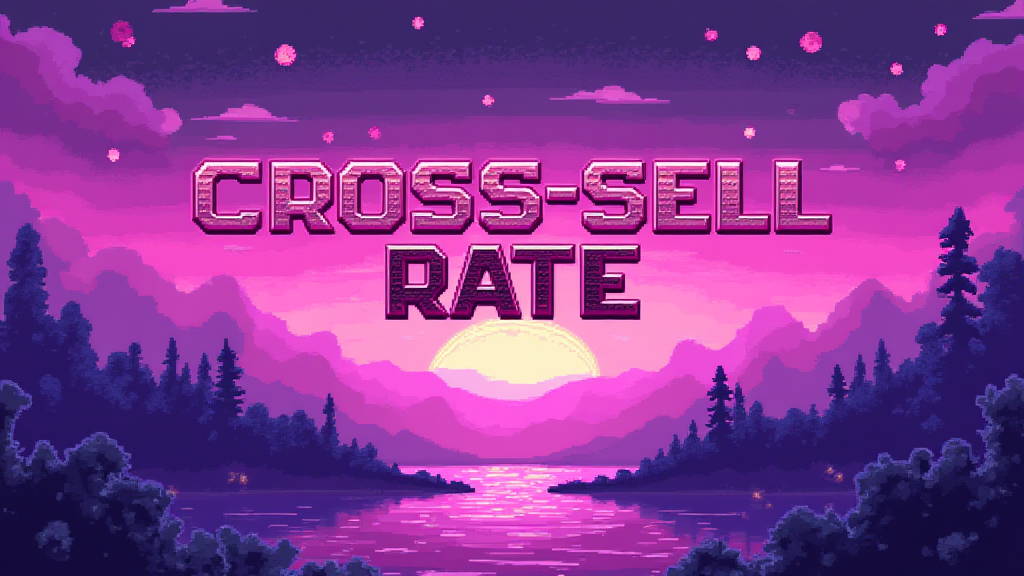Cross-Sell Rate: Boost Your Revenue Potential

Published on: October 01, 2024
In the world of sales and marketing, maximizing revenue from existing customers is a crucial strategy for business growth. One key metric that measures this effectiveness is the cross-sell rate. 📈
The cross-sell rate is the percentage of customers who purchase additional products or services that are related to or complement their initial purchase. This metric is essential for businesses looking to increase their average order value and customer lifetime value.
Understanding Cross-Sell Rate
Cross-selling is the practice of offering customers complementary products or services based on their current or past purchases. The cross-sell rate quantifies the success of these efforts. A higher cross-sell rate indicates that your sales team is effectively identifying and capitalizing on opportunities to provide additional value to customers.
Calculating Cross-Sell Rate
To calculate the cross-sell rate, use the following formula:
$$\text{Cross-Sell Rate} = \frac{\text{Number of customers who made additional purchases}}{\text{Total number of customers}} \times 100$$
For example, if you have 1,000 customers and 250 of them purchased additional products, your cross-sell rate would be 25%.
Importance of Cross-Sell Rate in Sales and Marketing
Understanding and optimizing your cross-sell rate can have significant benefits for your business:
- Increased Revenue: By selling additional products to existing customers, you can boost overall revenue without the cost of acquiring new customers.
- Enhanced Customer Loyalty: Offering relevant products can improve customer satisfaction and strengthen relationships.
- Improved Customer Lifetime Value: Successful cross-selling can increase the total value a customer brings to your business over time.
- Cost-Effective Growth: It's often more cost-effective to sell to existing customers than to acquire new ones.
Strategies to Improve Cross-Sell Rate
To boost your cross-sell rate and maximize revenue potential, consider implementing these strategies:
- Understand Customer Needs: Analyze customer data to identify patterns and preferences that can inform cross-selling opportunities.
- Personalize Recommendations: Use AI and machine learning to provide tailored product suggestions based on customer behavior and purchase history.
- Train Your Sales Team: Equip your sales representatives with the knowledge and skills to identify and present cross-selling opportunities effectively.
- Optimize Timing: Present cross-sell offers at the right moment in the customer journey for maximum impact.
- Bundle Products: Create attractive packages that combine complementary products or services at a competitive price.
Common Challenges in Cross-Selling
While cross-selling can be highly effective, it's important to be aware of potential pitfalls:
- Irrelevant Offers: Pushing products that don't align with customer needs can harm relationships and decrease trust.
- Overwhelming Customers: Bombarding customers with too many options can lead to decision paralysis and lost sales.
- Neglecting Customer Service: Focusing too heavily on sales can detract from providing quality customer support.
- Lack of Integration: Poor integration between sales and marketing teams can result in missed opportunities and inconsistent messaging.
Measuring and Tracking Cross-Sell Rate
To effectively improve your cross-sell rate, it's crucial to track and analyze your performance over time. Consider the following metrics alongside your cross-sell rate:
| Metric | Description |
|---|---|
| Average Order Value (AOV) | The average amount spent by customers per transaction |
| Customer Lifetime Value (CLV) | The total revenue a customer is expected to generate over their relationship with your business |
| Conversion Rate | The percentage of customers who accept a cross-sell offer |
| Revenue per Customer | The average revenue generated by each customer |
By monitoring these metrics alongside your cross-sell rate, you can gain a comprehensive understanding of your cross-selling performance and identify areas for improvement.
Implementing Cross-Selling in Your Sales and Marketing Stack
To effectively implement and optimize cross-selling in your organization, consider asking yourself the following questions:
- How can we leverage our CRM data to identify the best cross-selling opportunities?
- What technologies can we implement to automate and personalize cross-sell recommendations?
- How can we align our sales and marketing teams to create a seamless cross-selling strategy?
- What training programs can we develop to improve our team's cross-selling skills?
- How can we test and optimize our cross-selling approaches to maximize our cross-sell rate?
By addressing these questions and continuously refining your cross-selling strategies, you can boost your cross-sell rate and drive significant revenue growth for your business. 🚀

















